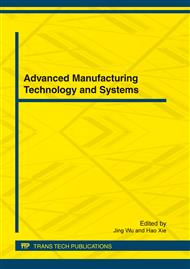p.46
p.51
p.56
p.69
p.74
p.79
p.84
p.88
p.93
Based on SolidWorks COSMOS 2.5 Tons, 4m•s-1 High Speed the Elevator Drive's Finite Element Analysis
Abstract:
Drive as the high-speed elevator's power input device, its function is to drag car and counterweight running in the hatchway. Drive's working status has significant impact to elevator's safety, dependability and comfort. Through the FEA on high-speed elevator's drive machine, and basis theoretical is used to provide reason for stress calculating and theoretical analyses. First, treat the drive device's stress with reasonable structure simplifying. Second, by the Plug-in SolidWorks COSMOS exert 3D modeling on load and constrain. The last, executing the FEA gets stress and strain cloud. Contrast the FEA analysis on the drive device with actual observation outcome, it shows that they are similarity, the analysis outcomes demonstrate the method of research to be reasonable, it has great meaning for high-speed and great capacity elevator's research. Provide directions for in-depth development.
Info:
Periodical:
Pages:
74-78
Citation:
Online since:
March 2012
Authors:
Keywords:
Price:
Сopyright:
© 2012 Trans Tech Publications Ltd. All Rights Reserved
Share:
Citation:


